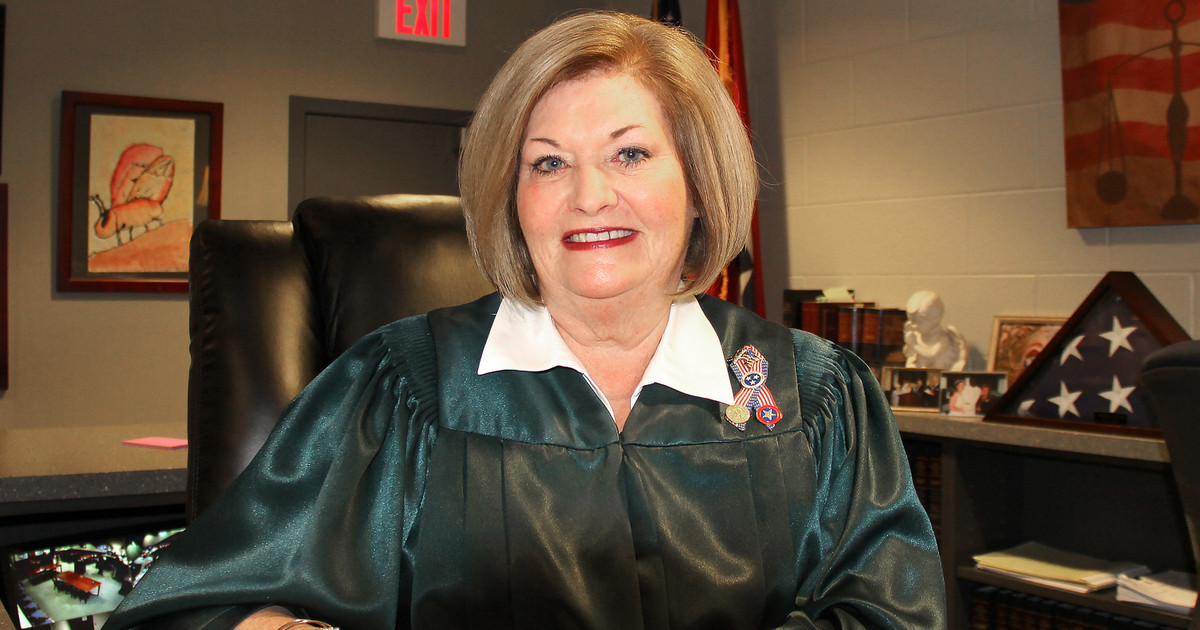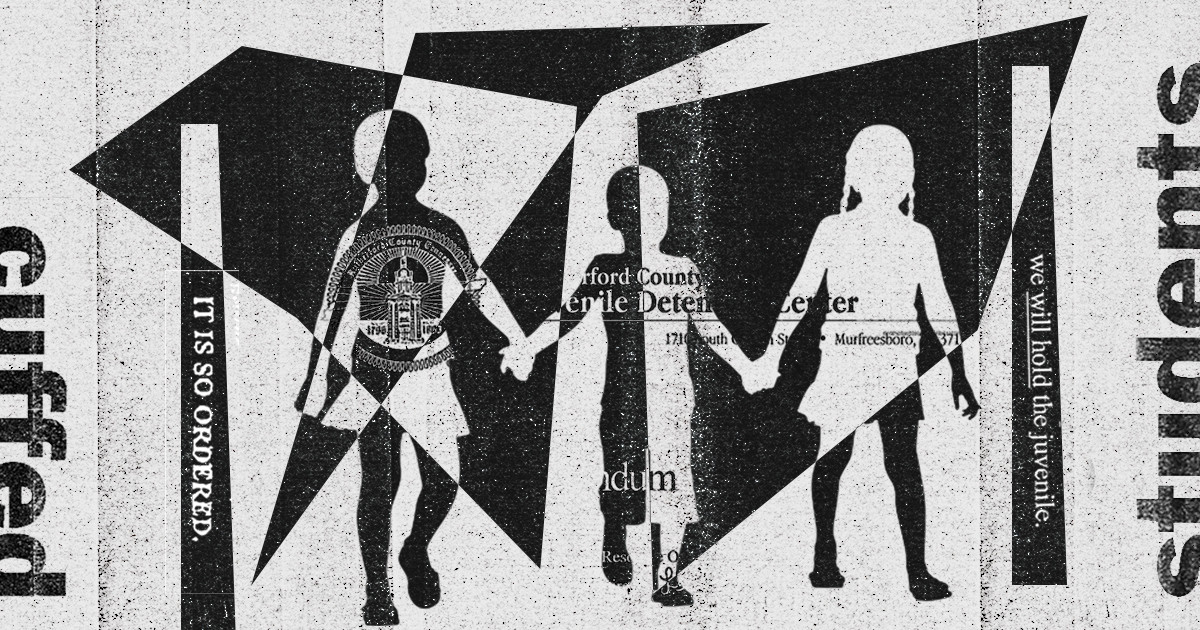
Black Children Were Jailed for a Crime That Doesn’t Exist. Almost Nothing Happened to the Adults in Charge.
Judge Donna Scott Davenport oversees a juvenile justice system in Rutherford County, Tennessee, with a staggering history of jailing children. She said kids must face consequences, which rarely seem to apply to her or the other adults in charge.
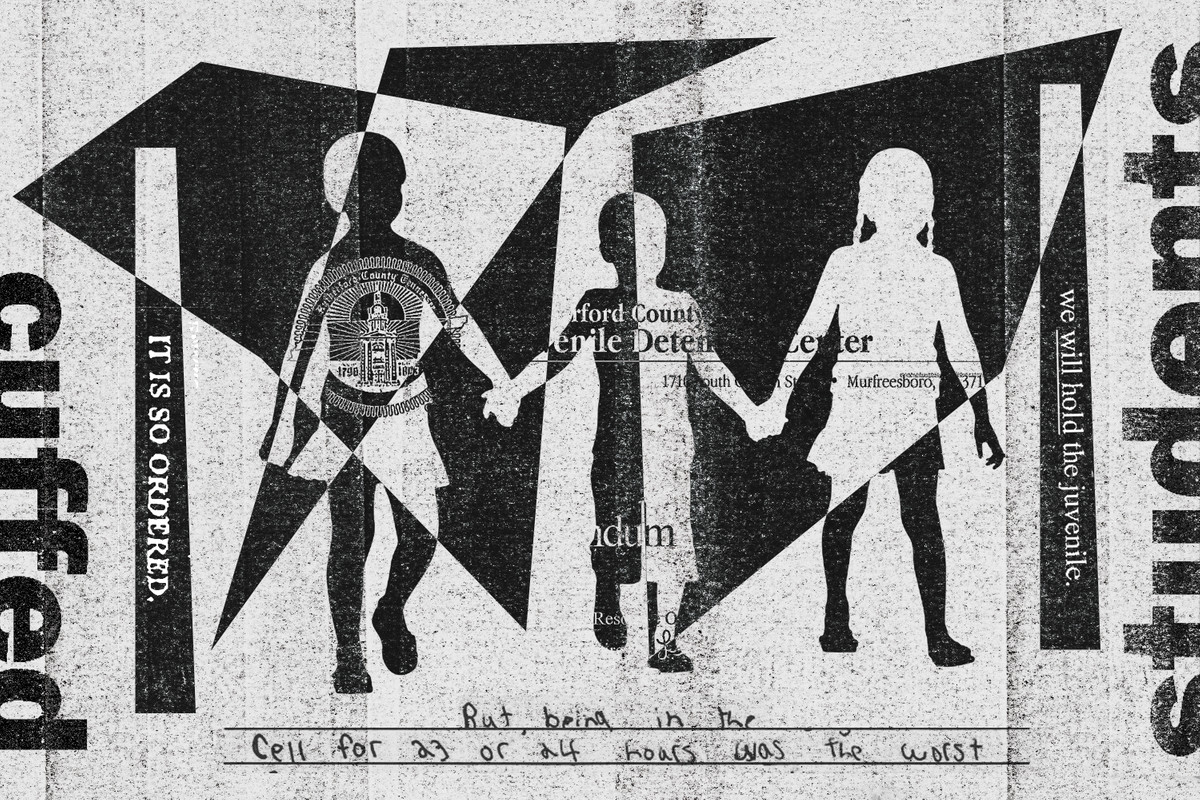
Judge Donna Scott Davenport oversees a juvenile justice system in Rutherford County, Tennessee, with a staggering history of jailing children. She said kids must face consequences, which rarely seem to apply to her or the other adults in charge.
Chapter 1: “What in the World?”
Friday, April 15, 2016: Hobgood Elementary School, Murfreesboro, Tennessee
Three police officers were crowded into the assistant principal’s office at Hobgood Elementary School, and Tammy Garrett, the school’s principal, had no idea what to do. One officer, wearing a tactical vest, was telling her: Go get the kids. A second officer was telling her: Don’t go get the kids. The third officer wasn’t saying anything.
Garrett knew the police had been sent to arrest some children, although exactly which children, it would turn out, was unclear to everyone, even to these officers. The names police had given the principal included four girls, now sitting in classrooms throughout the school. All four girls were Black. There was a sixth grader, two fourth graders and a third grader. The youngest was 8. On this sunny Friday afternoon in spring, she wore her hair in pigtails.
A few weeks before, a video had appeared on YouTube. It showed two small boys, 5 and 6 years old, throwing feeble punches at a larger boy as he walked away, while other kids tagged along, some yelling. The scuffle took place off school grounds, after a game of pickup basketball. One kid insulted another kid’s mother, is what started it all.
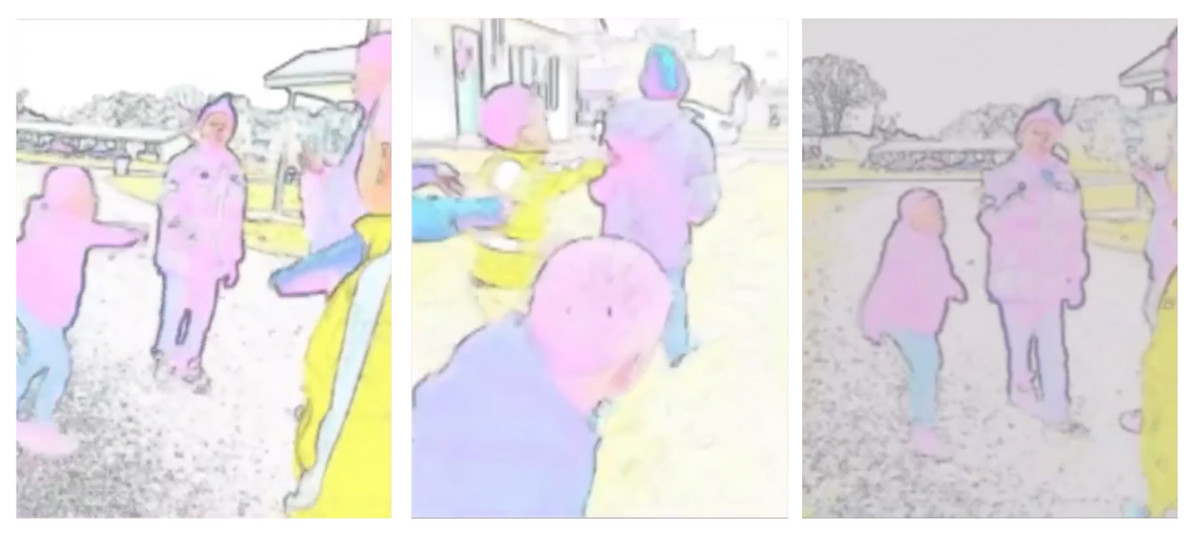
Screenshots from a heavily filtered video, originally posted to YouTube, showing a scuffle among small children that took place off school grounds.
The police were at Hobgood because of that video. But they hadn’t come for the boys who threw punches. They were here for the children who looked on. The police in Murfreesboro, a fast-growing city about 30 miles southeast of Nashville, had secured juvenile petitions for 10 children in all who were accused of failing to stop the fight. Officers were now rounding up kids, even though the department couldn’t identify a single one in the video, which was posted with a filter that made faces fuzzy. What was clear were the voices, including that of one girl trying to break up the fight, saying: “Stop, Tay-Tay. Stop, Tay-Tay. Stop, Tay-Tay.” She was a fourth grader at Hobgood. Her initials were E.J.
The confusion at Hobgood — one officer saying this, another saying that — could be traced in part to absence. A police officer regularly assigned to Hobgood, who knew the students and staff, had bailed that morning after learning about the planned arrests. The thought of arresting these children caused him such stress that he feared he might cry in front of them. Or have a heart attack. He wanted nothing to do with it, so he complained of chest pains and went home, with no warning to his fill-in about what was in store.
Also absent was the police officer who had investigated the video and instigated these arrests, Chrystal Templeton. She had assured the principal she would be there. She had also told Garrett there would be no handcuffs, that police would be discreet. But Templeton was a no-show. Garrett even texted her — “How’s timing?” — but got no answer.
Instead of going to Hobgood, Templeton had spent the afternoon gathering the petitions, then heading to the Rutherford County Juvenile Detention Center, a two-tiered jail for children with dozens of surveillance cameras, 48 cells and 64 beds. There, she waited for the kids to be brought to her.
In Rutherford County, a juvenile court judge had been directing police on what she called “our process” for arresting children, and she appointed the jailer, who employed a “filter system” to determine which children to hold.
The judge was proud of what she had helped build, despite some alarming numbers buried in state reports.
Among cases referred to juvenile court, the statewide average for how often children were locked up was 5%.
In Rutherford County, it was 48%.
Rutherford County Locked Up Kids in Almost Half of Cases
Tennessee used to publish statistical reports on juvenile courts statewide. For the last year available, 2014, we compiled reports for all 98 courts. Rutherford County locked up kids in 48% of its cases, eclipsing every other jurisdiction. (The graphic below shows the top 50 courts.) The state stopped publishing this data even as it figured prominently in a lawsuit against Rutherford County.
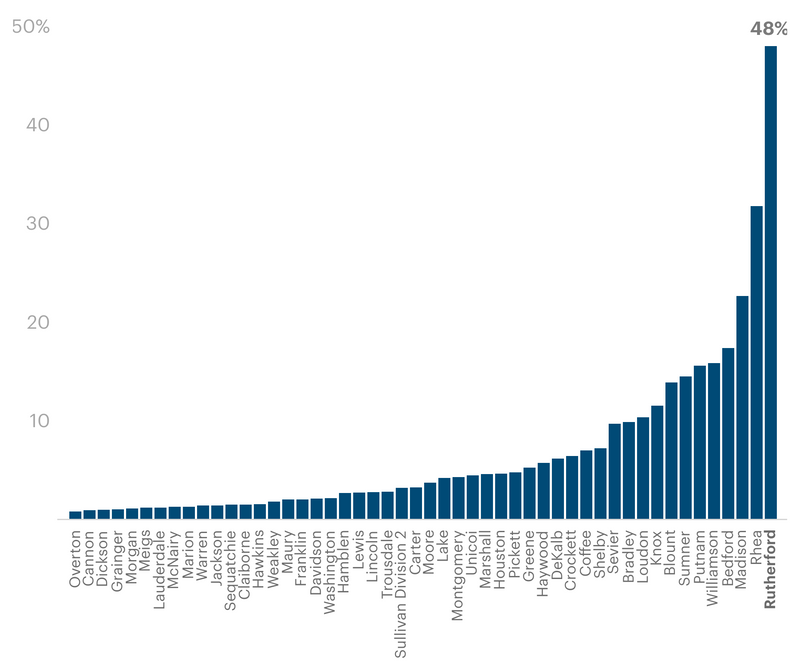
In the assistant principal’s office at Hobgood, the officer telling Garrett not to get the kids was Chris Williams. Williams, who is Black, had been a Murfreesboro cop for five years. “What in the world?” he thought, when he learned what these arrests were about. At Hobgood, two-thirds of the students were Black or Latino. Williams wondered if such arrests would be made at a school that was mostly white. He had a daughter who was 9. He pictured her being arrested. This is going to blow up, he thought; I’m going to end up in federal court over this. He considered quitting, but instead tried to get someone to intervene. Tucked in an office corner, he called a sergeant, a lieutenant and a major, but couldn’t find anyone to call it off.
The officer not saying anything was Albert Miles III. Growing up, Miles, who is Black, had friends who hated the police. But Miles’ dad was a cop. Miles wanted to prove that police could be trusted. That afternoon, Miles had been pulled out of roll call along with another officer; a sergeant told the two to go arrest some kids at Hobgood. The sergeant didn’t say why, but at Hobgood, Miles started picking up details. Miles, too, wondered if these arrests would happen at a school full of white students.
The third officer at Hobgood was Jeff Carroll. He’d been pulled out of roll call with Miles. Carroll, who is white, was a patrol officer and SWAT team member. In evaluations, supervisors praised him as a leader, “cool under pressure.” Carroll also had no idea what these arrests were about. But his sergeant had ordered them, and he followed orders. Carroll was the officer telling the principal: Go get the kids.
Garrett asked if she could call their parents first. Carroll told her no. Garrett told the police that one girl had diabetes and got treatment when she arrived home after school. Please, the principal said. Let me call her parent. On this, the police ultimately compromised, saying the girl could get a shot in the nurse’s office before being taken to the jail.
Of the two officers telling Garrett what to do — get the kids, don’t get the kids — Carroll seemed the more aggressive, the principal would say later. She agreed to get the kids.
Hobgood’s Tammy Garrett
Having these arrests take place at Hobgood was not something school officials wanted. They wanted kids to feel safe at school. Garrett grew up poor. Nine-tenths of her students were poor. Years before, Hobgood had struggled academically. Now it was a celebrated success. Garrett and her staff had worked to build trust with parents, with students. “I don’t give up on kids,” Garrett says. But she knew that trust is fragile, and trauma endures.
As Garrett gathered the girls from their classrooms, she believed the police would at least avoid a spectacle. School let out at 2:30. That was minutes away. Garrett’s understanding was that the police would keep the girls in the office until school was dismissed and everyone else was gone.
Garrett rounded up the sixth grader, a tall girl with braids who had visions of becoming a police officer; one of the fourth graders, the girl with diabetes; and the 8-year-old third grader. In the hallway, the principal tried to prepare them, saying the police were there regarding a video of a fight. Hearing this, the sixth grader told Garrett that the two other girls hadn’t even been there.
After returning to the office with the three girls, Garrett relayed to police what the sixth grader had told her.
Her words were barely out when Carroll made it clear he’d had enough, Garrett said later when interviewed as part of an internal police investigation.
Carroll pulled out handcuffs and put them “right in my face,” Garrett recalled.
“And he said, ‘We’re going now, we’re going now, there’s no more talk, and we’re going now.’
“And I said, ‘But, but, but.’”
d. She felt intimidated. Bullied. She worried that if she said any more, she might be arrested herself. “And so I backed off.”
By now the girls were crying and screaming and reaching for the principal, who was also crying, as was the assistant principal. “And it was, it was, it was awful,” Garrett later said.
Carroll handcuffed the sixth grader. Later, asked why, he said because policy allowed him to. After being handcuffed, the sixth grader fell to her knees.
A chalk drawing outside Hobgood Elementary School
Miles handcuffed the 8-year-old with pigtails. “Just acting out of habit,” he said later. Walking to a patrol car, Miles stopped and thought, “Wait a minute,” and removed the cuffs. “I guess my brain finally caught up with what was going on.”
While Carroll drove those two girls to the jail, the fourth grader with diabetes stayed behind to see the nurse. She was sisters with the sixth grader; her initials were C.C.
In all this back and forth, Principal Garrett realized something. The other fourth grader. She had forgotten about her. And now, school was out. The girl had boarded her bus, and was waiting to go home.
The other fourth grader was E.J. Although she’d said “stop,” she was on the police’s list to be picked up for encouraging the fight.
Go get her, the police told Garrett.
Garrett was still crying. She didn’t want to go out to the line of buses and let all those kids see her like that. But she went, feeling she had little choice.
A teacher beckoned E.J. off the bus. Then Garrett escorted her inside, to the awaiting police. E.J., scared and confused, begged for her mother — and threw up on the floor.
The two fourth graders still at Hobgood, E.J. and C.C., were best friends. Williams and Miles walked the girls outside, not handcuffing either. With some parents joining in, the officers formed a prayer circle around the two girls. Miles prayed out loud for the kids to be protected and for God to bring peace and understanding. Then he buckled the fourth graders into a patrol car and drove off. On the way to jail the girls cried, “snot and all,” E.J. would say later. Garrett, meanwhile, pulled out her personal cellphone and began calling parents, no longer willing to do as the police commanded.
For the officers, the confusion didn’t end at the school. It continued once the children began arriving at the jail.
When Carroll walked in with the first two girls, Templeton, the investigating officer, pointed to the 8-year-old and asked what she was doing there. The police had no petition for her, Templeton said. The 8-year-old’s mother soon arrived and took her child home.
Left: The playground at Hobgood Elementary School. Right: Rutherford County Juvenile Detention Center.
Miles brought in the last two girls, the two fourth graders. Then, walking out to his patrol car, he ran into an angry parent, Miles would recall later. It was a father demanding answers. Miles dropped his head, shaking it. The father asked why this was happening. I don’t know, Miles answered. We are good people, the father said. I can only imagine what you’re feeling, Miles answered. He explained, briefly, the juvenile court process. This is wrong, the father told Miles, over and over. After the third time, Miles, fighting back tears, said he understood, as a parent himself, the father’s anger and pain.
Fuck you, the father said.
I understand, Miles answered.
Only later, when he returned to the police station, did Miles allow himself to cry.
When the parent asked why this was happening, Miles had been unable to say. But the answer traces to individual missteps and institutional breakdowns — all on a grand scale.
What happened on that Friday and in the days after, when police rounded up even more kids, would expose an ugly and unsettling culture in Rutherford County, one spanning decades. In the wake of these mass arrests, lawyers would see inside a secretive legal system that’s supposed to protect kids, but in this county did the opposite. Officials flouted the law by wrongfully arresting and jailing children. One of their worst practices was stopped following the events at Hobgood, but the conditions that allowed the lawlessness remain. The adults in charge failed. Yet they’re still in charge. Tennessee’s systems for protecting children failed. Yet they haven’t been fixed.


